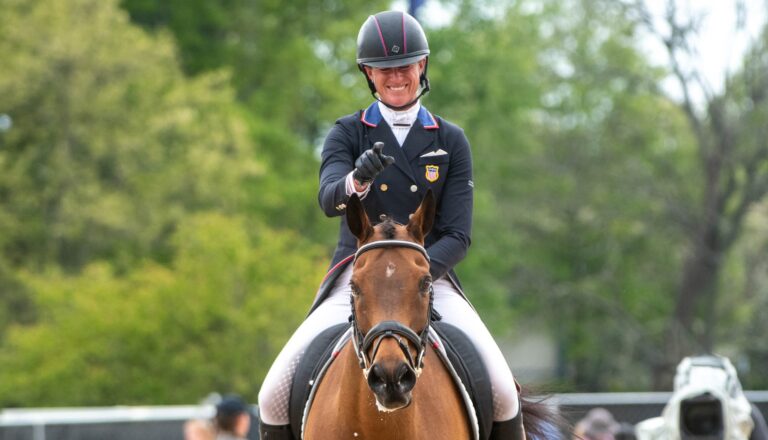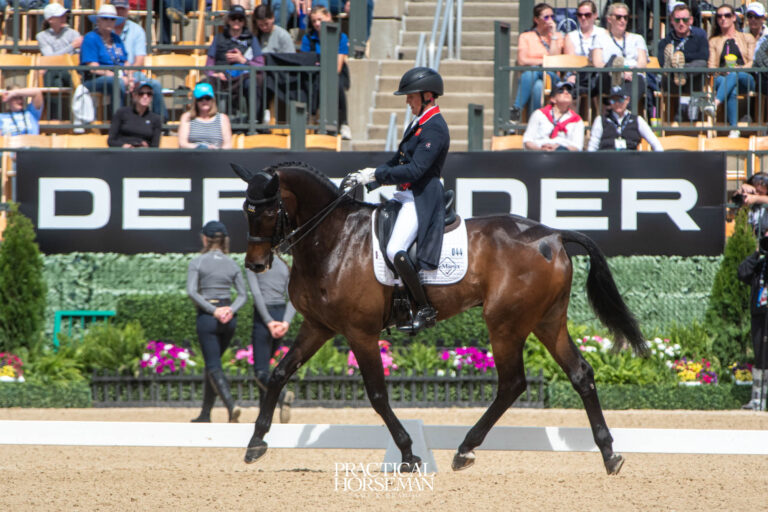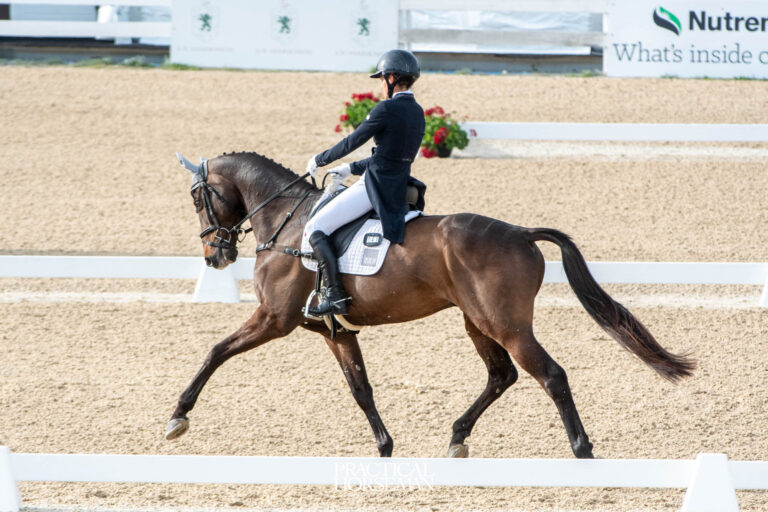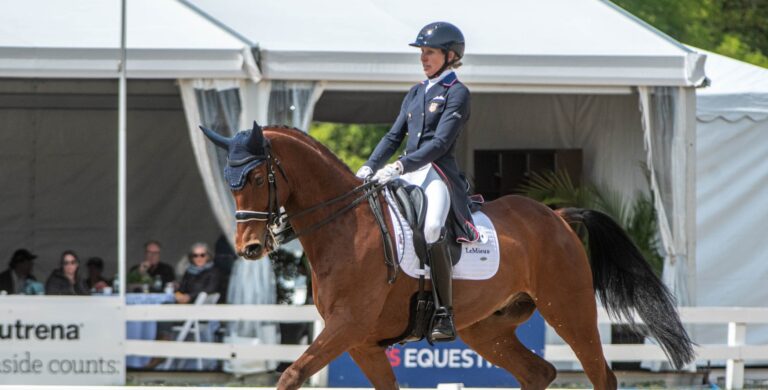With dressage and eventing trainer Chelsea Canedy’s knowledge of horse behavior and natural horsemanship, she is able “to identify and develop the potential in a horse with empathy, patience and understanding,” according to her website. That approach encouraged the trainer from Wales, Maine, to take on a new challenge in the 2024 Mustang Classic.
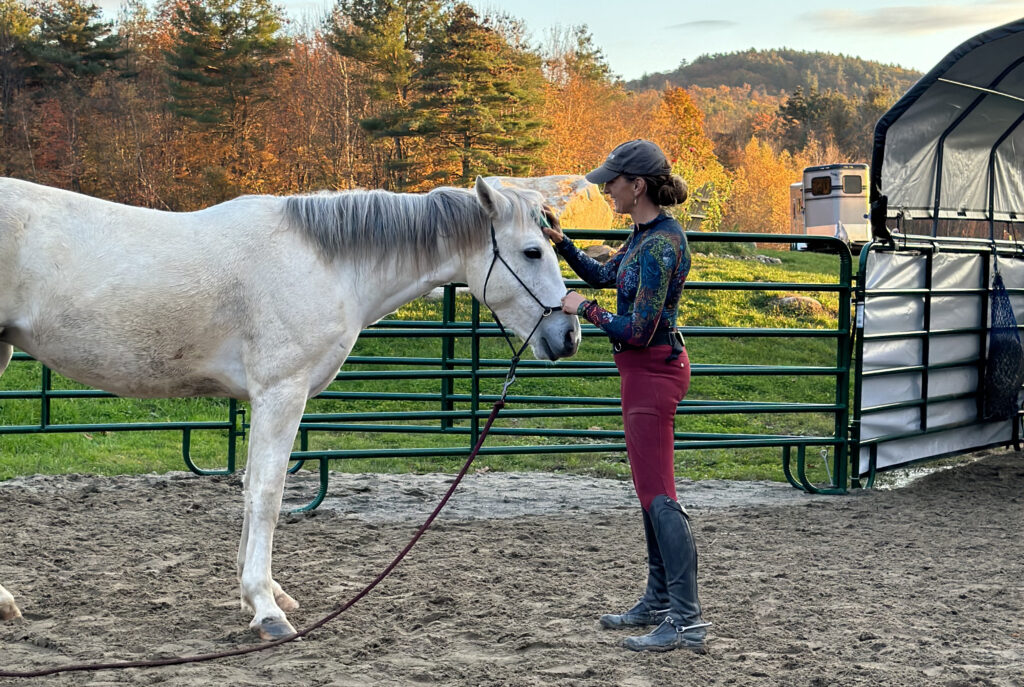
Courtesy, Brooke Hulford
Exhibitors and their purchased or adopted mustangs will compete in the inaugural event in September 2024 at the Kentucky Horse Park in Lexington. The competition features mustangs across Training level dressage, show jumping, arena cross country and working equitation. Its goal is to showcase the bond between humans and mustangs and to highlight their potential and adaptability in the equestrian world.
The competition welcomes mustangs 3 years of age and older, as of January 2024, that are adopted or purchased at a Bureau of Land Management off-range corral or BLM satellite event. Mustangs must be adopted during the eligibility window of September 8, 2023, through June 1, 2024.
Here Canedy explains why she wanted to get involved in the Mustang Classic, how she found her horse, Luna, and how the training is progressing.
DT: How did you decide to become involved in training a mustang for the Mustang Classic?
CC: In August I was talking with my friend Tik Maynard, who is participating in Road to the Horse (a colt-starting event featuring American Quarter Horses) this March. He mentioned that if he wasn’t doing that, he would want to do the Mustang Classic. I hadn’t heard of it, so he sent me the email he had received introducing the competition and told me I should do it.
Once I looked into it, I thought it sounded right up my alley. I love the idea of having a whole year to develop a relationship with and train a horse that has never been handled by humans, and to then have the opportunity to showcase the skill that goes into that process in a competitive space. Especially since it encourages me to play in all the areas of training I love—dressage, jumping and liberty and bridleless work to put together a freestyle. All the things that bring me joy about working with horses are what would make me highly competitive in this particular event, which is so cool and unusual. I couldn’t pass up the shot at it.
DT: Tell us about your mustang. How did you find her and what made you decide she was the one you wanted?
CC: Being as far east as I am located, it was hard to find a mustang. I joined every mustang Facebook group I could find and started putting feelers out for a horse that met the competition criteria. A lovely woman name Meg Magsig, who was a long time Trainer Incentive Program (TIP) trainer for the Mustang Heritage Foundation, commented on one of my posts, which led to a conversation and a plan between the two of us.
Meg went to the holding pens in Ewing, Illinois, and scouted for me a few days after we talked. While there, she sent me photos and videos of the available horses that might work. My criteria were to find one on the taller side—I am 5 feet, 7 inches tall with very long legs—and over the age of 4, as I wanted the joints to be developed enough to handle the impact of jumping.
There were a few that caught Meg’s eye, but a gray mare in particular had a wonderful expression and seemed to be watching Meg carefully, tracking her movements outside the pen. She had an athletic build and was a little lighter bodied than many there, which is appealing for English disciplines. We learned she is 6 years old and was from the Twin Peaks Herd Management Area in California—Meg told me that the California mustangs have a reputation for being lovely horses. After a little back and forth with my wonderful clients who are helping on this journey, we decided to take a chance on the gray mare.
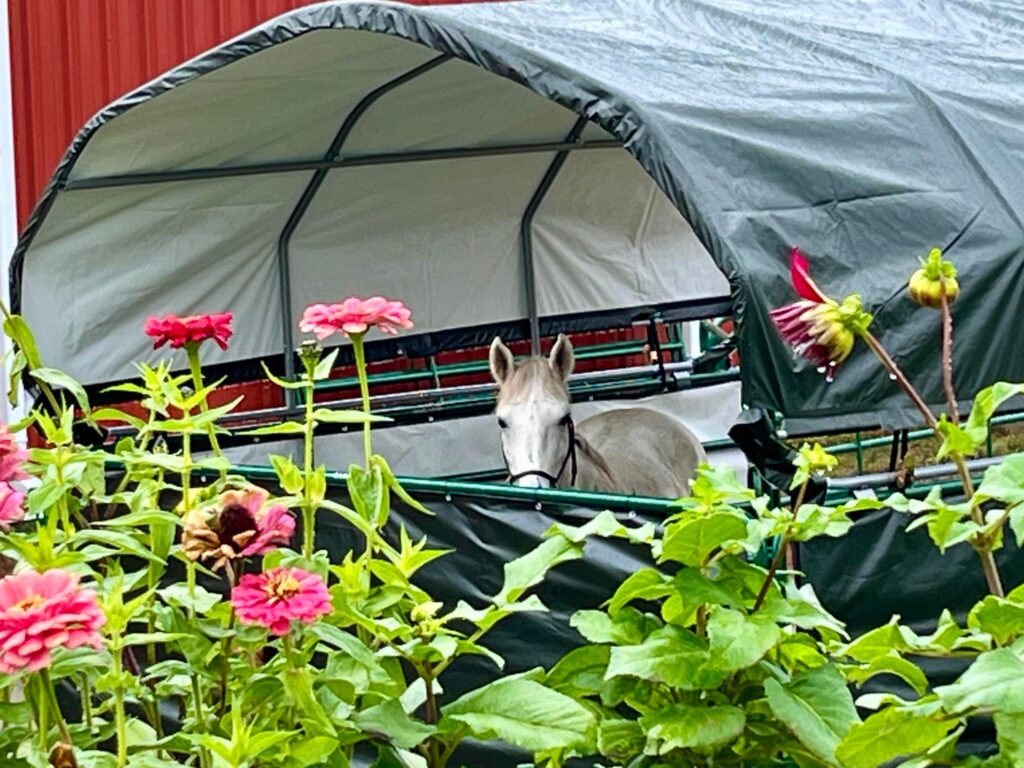
Courtesy, Michael Frankel
Meg picked her up the next day and took her to her farm in Ohio, where she lived for about three weeks. Then Meg brought her to me in Lexington, Kentucky, where I was teaching at the Liberty Festival (an expo dedicated entirely to liberty work held October 13-15, 2023). Meg had started some basic handling with the mare that I had by then named Luna, so that she could be caught and put onto a trailer. This was essential for my being able to get her back to Maine safely. Meg did an amazing job in those three weeks, getting to know Luna, sending me countless videos of their interactions and having many conversations with me over the phone. When I met Luna for the first time, I felt like I knew a lot about her already.
DT: What are your impressions of her so far?
Luna is so smart. She figures things out amazingly quickly. She is a problem-solver-extraordinaire. She wants to get things right and tries really hard to figure out what I am asking. Sometimes she gets a little frustrated when she doesn’t understand right away. She is a horse that needs a lot of time between questions to think and settle before we can do the next thing, so patience on my part is a must. She is very sensitive to any perceived pressure, especially touch, and every reaction she gives me is so unbelievably genuine. She is teaching me so much about my own body language and intention. I have to be very aware of what I am doing with her and around her at all times. Every single new thing I do with her is the first time she has been asked that question or had that experience, so everything has to be broken down into manageable bites that build her confidence and trust. In this way, she is teaching me to be a better problem-solver, too.
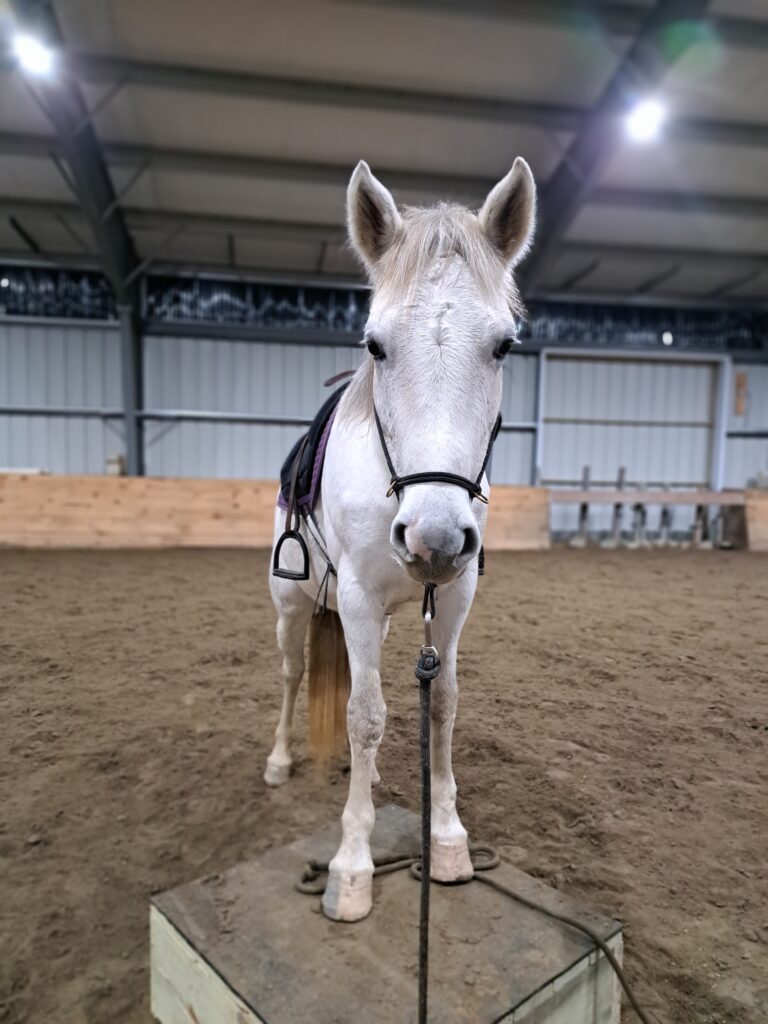
Courtesy, Chelsea Canedy
DT: What have you been doing with her?
CC: We have been working on haltering, brushing, leading next to me, walking into small spaces like barn aisles and stalls, blanketing, making circles around me at the walk, trot and adding some canter, both on the longe line and at liberty. We recently added the understanding of going with her head lower on her circle work. She knows how to yield her hind end away from me and mirror my steps laterally toward and away from her shoulder. She loves the pedestal (a solid, low box that the horse is trained to step up onto), so we work on her standing up on it with her front feet to rest and stretch there. We work on her standing quietly and patiently—Luna spends a lot of time in my arena with me while I teach lessons.
Luna is wearing a saddle and cavesson to work in, and we have been practicing her circling with me above her, standing on the pedestal. She is learning to accept me jumping up and down around her and allowing me to mount and sit on her from the pedestal. Luna walks and trots over poles and small jumps at liberty. She is coming to Florida with me at the beginning of January, and I am looking forward to what we can get done in the warm weather and sunshine.
DT: What would you consider the pros and cons of owning a mustang?
CC: I love the “blank slate” aspect of mustangs. For me, that is a huge pro, as I spend a lot of time in my business helping people solve problems that have been trained into horses. Sometimes these habits are so ingrained that they are hard to get to the bottom of. With Luna, everything she is learning about interacting with the human world is coming from me. So if a problem arises, I can more easily trace it back and hopefully find a solution.
I am also finding that she has so much common sense. She is more relaxed about the world and the things that go on in it—loud noises, activity, new objects—than pretty much any domestic horse I know.
As far as cons, I would say that their sensitivity to humans, who they perceive as predators, makes them not appropriate for everyone. You should have a good understanding of the way horses interact with each other so that you can give clear signals and read a mustang’s cues well, or it could be unsafe. They are, after all, very large wild animals with a completely intact survival instinct. This means they will do whatever they have to do to survive if they feel threatened.
DT: Do you feel, once trained, that mustangs are amateur appropriate?
CC: Like any other horse, their being amateur appropriate depends on the individual horse’s nature—some will be more relaxed and less sensitive naturally—and the quality of the training that goes into them. As in, were they rushed in their understanding of the things we want from them, or are they relaxed and comfortable with new ideas because someone gave them the opportunity to think through each new question and experience?
DT: What qualities does a mustang have that would make him suitable for dressage?
CC: So many mustangs are descended from Spanish horses, so it’s in their DNA. You can see it more obviously in some than others. I’ve seen some that I would swear were Lusitano or Pura Raza Española (PRE). They tend to be short coupled and muscular over their haunches, loins and backs, which helps in dressage. Some would more easily go farther than others up the Training Scale, depending on their conformation and innate tendency to be forward thinking. But all of them have the capacity to do basic correct lower-level work.
DT: What are you looking forward to over the next year with your mustang? What are you most excited about for the Mustang Classic?
CC: I am most looking forward to getting on Luna and getting her going under saddle. I am really taking my time getting to that point, and that patience has been paying off in the way she looks to me for reassurance and encouragement. I have experienced with her a couple of times now the sense of a wall coming down. She lets me get to the next level without any fuss or excitement because she accepts and trusts whatever I ask of her. I believe the initial riding will be like that if I take my time getting there.
I can’t wait to be able to hack her around the farm and watch her take in new experiences from on board, rather than next to her on the ground. I am really looking forward to watching her body develop and change as she develops muscle and gains confidence in the way she carries herself. I think she is going to look like a little Connemara when she’s filled out.
For the Classic, I am really excited to put together our freestyle. I have some fun ideas already brewing that I hope to have the opportunity to show the audience and judges there.
DT: Anything else you’d like to add?
CC: I want to say a special thank you to co-sponsors Alison Brigham and Michael Frankel, as well as the staff at Unexpected Farm, who are helping make this journey possible. It’s a huge undertaking, in terms of time and financial commitment, and I couldn’t do it without these amazing people.
To read about five-star eventer Elisa Wallace’s mustang experience, click here.
To learn more about the 2024 Mustang Classic, click here.
To read the official Rules and Regulations of the 2024 Mustang Classic, click here.





